A Two-Layer Graphene Nonwoven Fabric for Effective Electromagnetic Interference Shielding
Abstract
:1. Introduction
2. Experimental Section
2.1. Fabrication of GO Fibers
2.2. Preparation of 2-gNWFs
2.3. Preparation of gNWFs
2.4. Characterizations
3. Results and Discussion
3.1. Morphologies
3.2. EMI Shielding Properties
4. Conclusions
Author Contributions
Funding
Institutional Review Board Statement
Informed Consent Statement
Data Availability Statement
Acknowledgments
Conflicts of Interest
References
- Li, H.; Li, Z.; Zhang, B.; Tang, W.K.; Halang, W.A. Suppressing electromagnetic interference in direct current converters. IEEE Circ. Syst. Mag. 2009, 9, 10–28. [Google Scholar] [CrossRef]
- Maheswari, Y.U.; Amudha, A.; Kumar, L.A. Effect of EMI on electrical and electronic system and mitigation methods for low-and high-frequency applications. In Energy Audit and Management; CRC Press: Boca Raton, FL, USA, 2022; pp. 181–209. [Google Scholar]
- Hashemi, S.A.; Ghaffarkhah, A.; Hosseini, E.; Bahrani, S.; Najmi, P.; Omidifar, N.; Mousavi, S.M.; Amini, M.; Ghaedi, M.; Ramakrishna, S. Recent progress on hybrid fibrous electromagnetic shields: Key protectors of living species against electromagnetic radiation. Matter 2022, 5, 3807–3868. [Google Scholar] [CrossRef]
- Sankaran, S.; Deshmukh, K.; Ahamed, M.B.; Pasha, S.K. Recent advances in electromagnetic interference shielding properties of metal and carbon filler reinforced flexible polymer composites: A review. Compos. Part A Appl. Sci. Manuf. 2018, 114, 49–71. [Google Scholar] [CrossRef]
- Wanasinghe, D.; Aslani, F. A review on recent advancement of electromagnetic interference shielding novel metallic materials and processes. Compos. Part B Eng. 2019, 176, 107207. [Google Scholar] [CrossRef]
- Zhu, R.; Li, Z.; Deng, G.; Yu, Y.; Shui, J.; Yu, R.; Pan, C.; Liu, X. Anisotropic magnetic liquid metal film for wearable wireless electromagnetic sensing and smart electromagnetic interference shielding. Nano Energy 2022, 92, 106700. [Google Scholar] [CrossRef]
- Dassan, E.G.B.; Ab Rahman, A.A.; Abidin, M.S.Z.; Akil, H.M. Carbon nanotube–reinforced polymer composite for electromagnetic interference application: A review. Nanotechnol. Rev. 2020, 9, 768–788. [Google Scholar] [CrossRef]
- Jia, L.-C.; Yue, Y.-F.; Zeng, J.; Wang, Z.; Nie, R.-P.; Xu, L.; Yan, D.-X.; Li, Z.-M. A review on thermal and electrical behaviours of liquid metal-based polymer composites. J. Mater. Chem. C 2023, 11, 12807–12827. [Google Scholar] [CrossRef]
- Kumar, P.; Narayan Maiti, U.; Sikdar, A.; Kumar Das, T.; Kumar, A.; Sudarsan, V. Recent advances in polymer and polymer composites for electromagnetic interference shielding: Review and future prospects. Polym. Rev. 2019, 59, 687–738. [Google Scholar] [CrossRef]
- Xia, Y.; Gao, W.; Gao, C. A review on graphene-based electromagnetic functional materials: Electromagnetic wave shielding and absorption. Adv. Funct. Mater. 2022, 32, 2204591. [Google Scholar] [CrossRef]
- Chen, Y.; Li, J.; Li, T.; Zhang, L.; Meng, F. Recent advances in graphene-based films for electromagnetic interference shielding: Review and future prospects. Carbon 2021, 180, 163–184. [Google Scholar] [CrossRef]
- Shen, X.; Kim, J.-K. Graphene and MXene-based porous structures for multifunctional electromagnetic interference shielding. Nano Res. 2023, 16, 1387–1413. [Google Scholar] [CrossRef]
- Sun, X.; Liu, X.; Shen, X.; Wu, Y.; Wang, Z.; Kim, J.-K. Graphene foam/carbon nanotube/poly (dimethyl siloxane) composites for exceptional microwave shielding. Compos. Part A Appl. Sci. Manuf. 2016, 85, 199–206. [Google Scholar] [CrossRef]
- Zeng, Z.; Chen, M.; Jin, H.; Li, W.; Xue, X.; Zhou, L.; Pei, Y.; Zhang, H.; Zhang, Z. Thin and flexible multi-walled carbon nanotube/waterborne polyurethane composites with high-performance electromagnetic interference shielding. Carbon 2016, 96, 768–777. [Google Scholar] [CrossRef]
- Singh, A.K.; Shishkin, A.; Koppel, T.; Gupta, N. A review of porous lightweight composite materials for electromagnetic interference shielding. Compos. Part B Eng. 2018, 149, 188–197. [Google Scholar] [CrossRef]
- Wang, Y.-Y.; Zhang, F.; Li, N.; Shi, J.-F.; Jia, L.-C.; Yan, D.-X.; Li, Z.-M. Carbon-based aerogels and foams for electromagnetic interference shielding: A review. Carbon 2023, 205, 10–26. [Google Scholar] [CrossRef]
- Shen, B.; Li, Y.; Yi, D.; Zhai, W.; Wei, X.; Zheng, W. Microcellular graphene foam for improved broadband electromagnetic interference shielding. Carbon 2016, 102, 154–160. [Google Scholar] [CrossRef]
- Wu, Y.; Wang, Z.; Liu, X.; Shen, X.; Zheng, Q.; Xue, Q.; Kim, J.-K. Ultralight graphene foam/conductive polymer composites for exceptional electromagnetic interference shielding. ACS Appl. Mater. Interfaces 2017, 9, 9059–9069. [Google Scholar] [CrossRef] [PubMed]
- Das, P.; Deoghare, A.B.; Maity, S.R. Exploring the potential of graphene as an EMI shielding material—An overview. Mater. Today Proc. 2020, 22, 1737–1744. [Google Scholar] [CrossRef]
- Tan, X.; Yuan, Q.; Qiu, M.; Yu, J.; Jiang, N.; Lin, C.-T.; Dai, W. Rational design of graphene/polymer composites with excellent electromagnetic interference shielding effectiveness and high thermal conductivity: A mini review. J. Mater. Sci. Technol. 2022, 117, 238–250. [Google Scholar] [CrossRef]
- Liu, Y.; Xu, Z.; Zhan, J.; Li, P.; Gao, C. Superb electrically conductive graphene fibers via doping strategy. Adv. Mater. 2016, 28, 7941–7947. [Google Scholar] [CrossRef]
- Wang, L.; Wu, Y.; Wang, Y.; Li, H.; Jiang, N.; Niu, K. Laterally compressed graphene foam/acrylonitrile butadiene styrene composites for electromagnetic interference shielding. Compos. Part A Appl. Sci. Manuf. 2020, 133, 105887. [Google Scholar] [CrossRef]
- Al-Saleh, M.H.; Saadeh, W.H.; Sundararaj, U. EMI shielding effectiveness of carbon based nanostructured polymeric materials: A comparative study. Carbon 2013, 60, 146–156. [Google Scholar] [CrossRef]
- Li, N.; Huang, Y.; Du, F.; He, X.; Lin, X.; Gao, H.; Ma, Y.; Li, F.; Chen, Y.; Eklund, P.C. Electromagnetic interference (EMI) shielding of single-walled carbon nanotube epoxy composites. Nano Lett. 2006, 6, 1141–1145. [Google Scholar] [CrossRef]
- Jia, J.; Kan, C.-M.; Lin, X.; Shen, X.; Kim, J.-K. Effects of processing and material parameters on synthesis of monolayer ultralarge graphene oxide sheets. Carbon 2014, 77, 244–254. [Google Scholar] [CrossRef]
- Chang, D.; Liu, J.; Fang, B.; Xu, Z.; Li, Z.; Liu, Y.; Brassart, L.; Guo, F.; Gao, W.; Gao, C. Reversible fusion and fission of graphene oxide–based fibers. Science 2021, 372, 614–617. [Google Scholar] [CrossRef]
- Xu, Z.; Liu, Y.; Zhao, X.; Peng, L.; Sun, H.; Xu, Y.; Ren, X.; Jin, C.; Xu, P.; Wang, M. Ultrastiff and strong graphene fibers via full-scale synergetic defect engineering. Adv. Mater. 2016, 28, 6449–6456. [Google Scholar] [CrossRef]
- Cheng, Y.; Cui, G.; Liu, C.; Liu, Z.; Yan, L.; Liu, B.; Yuan, H.; Shi, P.; Jiang, J.; Huang, K. Electric current aligning component units during graphene fiber joule heating. Adv. Funct. Mater. 2022, 32, 2103493. [Google Scholar] [CrossRef]
- Ma, L.; Hamidinejad, M.; Wei, L.; Zhao, B.; Park, C.B. Absorption-dominant EMI shielding polymer composite foams: Microstructure and geometry optimization. Mater. Today Phys. 2023, 30, 100940. [Google Scholar] [CrossRef]
- Manobalan, S.; Bose, S.; Sumangala, T. Effect of thickness on the EMI shielding effectiveness of epoxy composites with cobalt ferrite and graphene. Mater. Today Proc. 2023, 90, 128–132. [Google Scholar]
- Oliveira, F.M.; Azadmanjiri, J.; Wang, X.; Yu, M.; Sofer, Z. Structure design and processing strategies of MXene-based materials for electromagnetic interference shielding. Small Methods 2023, 7, 2300112. [Google Scholar] [CrossRef]
- Cheng, Z.; Wang, R.; Wang, Y.; Cao, Y.; Shen, Y.; Huang, Y.; Chen, Y. Recent advances in graphene aerogels as absorption-dominated electromagnetic interference shielding materials. Carbon 2023, 205, 112–137. [Google Scholar] [CrossRef]
- Tian, K.; Hu, D.; Wei, Q.; Fu, Q.; Deng, H. Recent progress on multifunctional electromagnetic interference shielding polymer composites. J. Mater. Sci. Technol. 2023, 134, 106–131. [Google Scholar] [CrossRef]
- Wu, Y.; An, C.; Guo, Y.; Zong, Y.; Jiang, N.; Zheng, Q.; Yu, Z.-Z. Highly aligned graphene aerogels for multifunctional composites. Nano-Micro Lett. 2024, 16, 118. [Google Scholar] [CrossRef]
- Wu, Y.; An, C.; Guo, Y. 3D printed graphene and graphene/polymer composites for multifunctional applications. Materials 2023, 16, 5681. [Google Scholar] [CrossRef]
- Oliveira, F.M.; Luxa, J.; Bouša, D.; Sofer, Z.; Gusmão, R. Electromagnetic interference shielding by reduced graphene oxide foils. ACS Appl. Nano Mater. 2022, 5, 6792–6800. [Google Scholar] [CrossRef]
- Zhou, E.; Xi, J.; Guo, Y.; Liu, Y.; Xu, Z.; Peng, L.; Gao, W.; Ying, J.; Chen, Z.; Gao, C. Synergistic effect of graphene and carbon nanotube for high-performance electromagnetic interference shielding films. Carbon 2018, 133, 316–322. [Google Scholar] [CrossRef]
- Lai, D.; Chen, X.; Wang, G.; Xu, X.; Wang, Y. Highly conductive porous graphene film with excellent folding resilience for exceptional electromagnetic interference shielding. J. Mater. Chem. C 2020, 8, 8904–8916. [Google Scholar] [CrossRef]
- Xi, J.; Li, Y.; Zhou, E.; Liu, Y.; Gao, W.; Guo, Y.; Ying, J.; Chen, Z.; Chen, G.; Gao, C. Graphene aerogel films with expansion enhancement effect of high-performance electromagnetic interference shielding. Carbon 2018, 135, 44–51. [Google Scholar] [CrossRef]
- Wei, Q.; Pei, S.; Qian, X.; Liu, H.; Liu, Z.; Zhang, W.; Zhou, T.; Zhang, Z.; Zhang, X.; Cheng, H.M.; et al. Superhigh electromagnetic interference shielding of ultrathin aligned pristine graphene nanosheets film. Adv. Mater. 2020, 32, 1907411. [Google Scholar] [CrossRef]
- Mirkhani, S.A.; Iqbal, A.; Kwon, T.; Chae, A.; Kim, D.; Kim, H.; Kim, S.J.; Kim, M.-K.; Koo, C.M. Reduction of electrochemically exfoliated graphene films for high-performance electromagnetic interference shielding. ACS Appl. Mater. Interfaces 2021, 13, 15827–15836. [Google Scholar] [CrossRef]
- Li, C.-B.; Li, Y.-J.; Zhao, Q.; Luo, Y.; Yang, G.-Y.; Hu, Y.; Jiang, J.-J. Electromagnetic interference shielding of graphene aerogel with layered microstructure fabricated via mechanical compression. ACS Appl. Mater. Interfaces 2020, 12, 30686–30694. [Google Scholar] [CrossRef] [PubMed]
- Bi, S.; Zhang, L.; Mu, C.; Liu, M.; Hu, X. Electromagnetic interference shielding properties and mechanisms of chemically reduced graphene aerogels. Appl. Surf. Sci. 2017, 412, 529–536. [Google Scholar] [CrossRef]
- Xu, J.; Li, R.; Ji, S.; Zhao, B.; Cui, T.; Tan, X.; Gou, G.; Jian, J.; Xu, H.; Qiao, Y.; et al. Multifunctional graphene microstructures inspired by honeycomb for ultrahigh Performance electromagnetic interference shielding and wearable applications. ACS Nano 2021, 15, 8907–8918. [Google Scholar] [CrossRef]
- Kashani, H.; Giroux, M.; Johnson, I.; Han, J.; Wang, C.; Chen, M. Unprecedented electromagnetic interference shielding from three-dimensional bi-continuous nanoporous graphene. Matter 2019, 1, 1077–1087. [Google Scholar] [CrossRef]
- Zhang, L.; Alvarez, N.T.; Zhang, M.; Haase, M.; Malik, R.; Mast, D.; Shanov, V. Preparation and characterization of graphene paper for electromagnetic interference shielding. Carbon 2015, 82, 353–359. [Google Scholar] [CrossRef]
- Yin, J.; Zhang, J.; Zhang, S.; Liu, C.; Yu, X.; Chen, L.; Song, Y.; Han, S.; Xi, M.; Zhang, C.; et al. Flexible 3D porous graphene film decorated with nickel nanoparticles for absorption-dominated electromagnetic interference shielding. Chem. Eng. J. 2021, 421, 129763. [Google Scholar] [CrossRef]
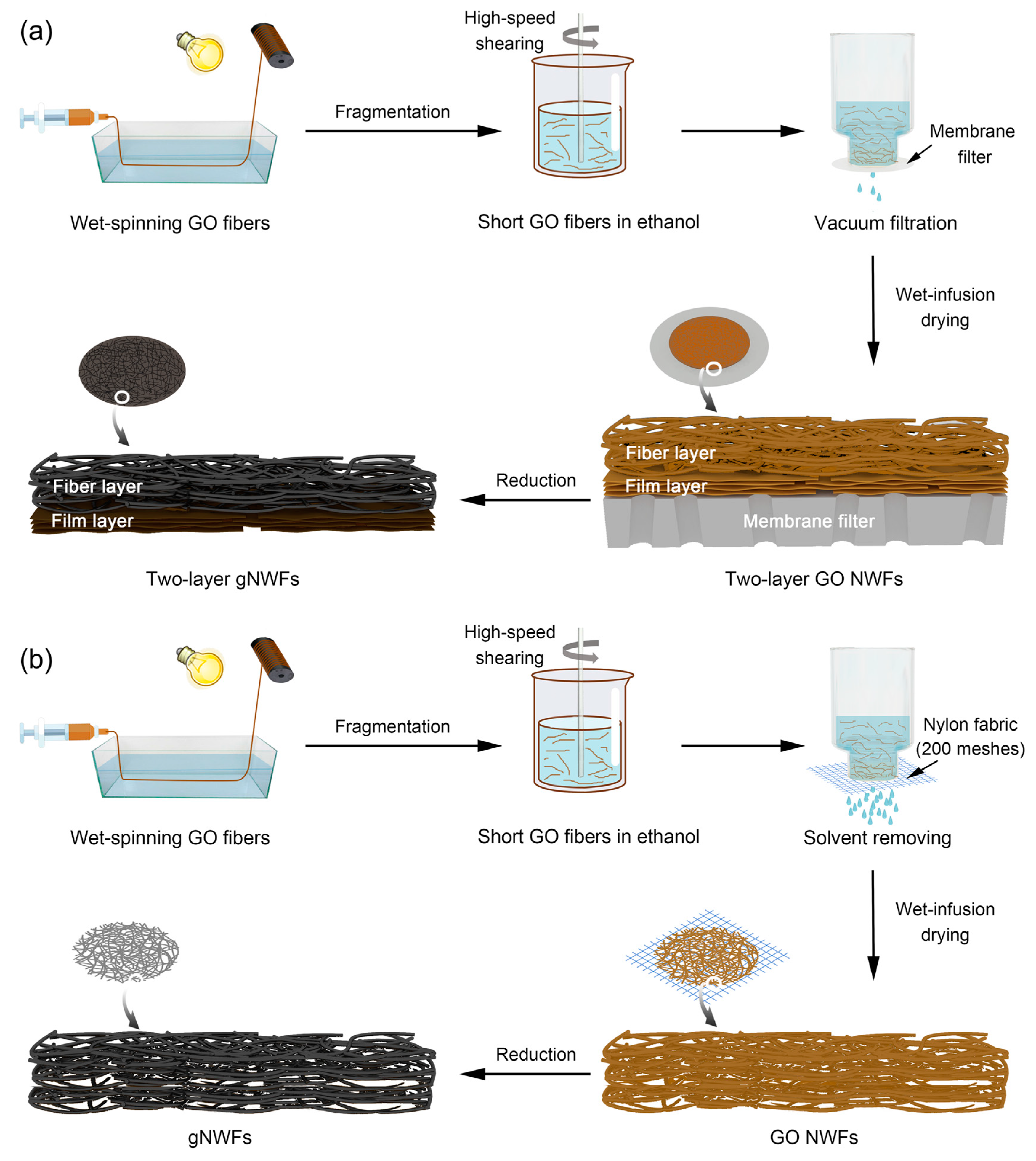
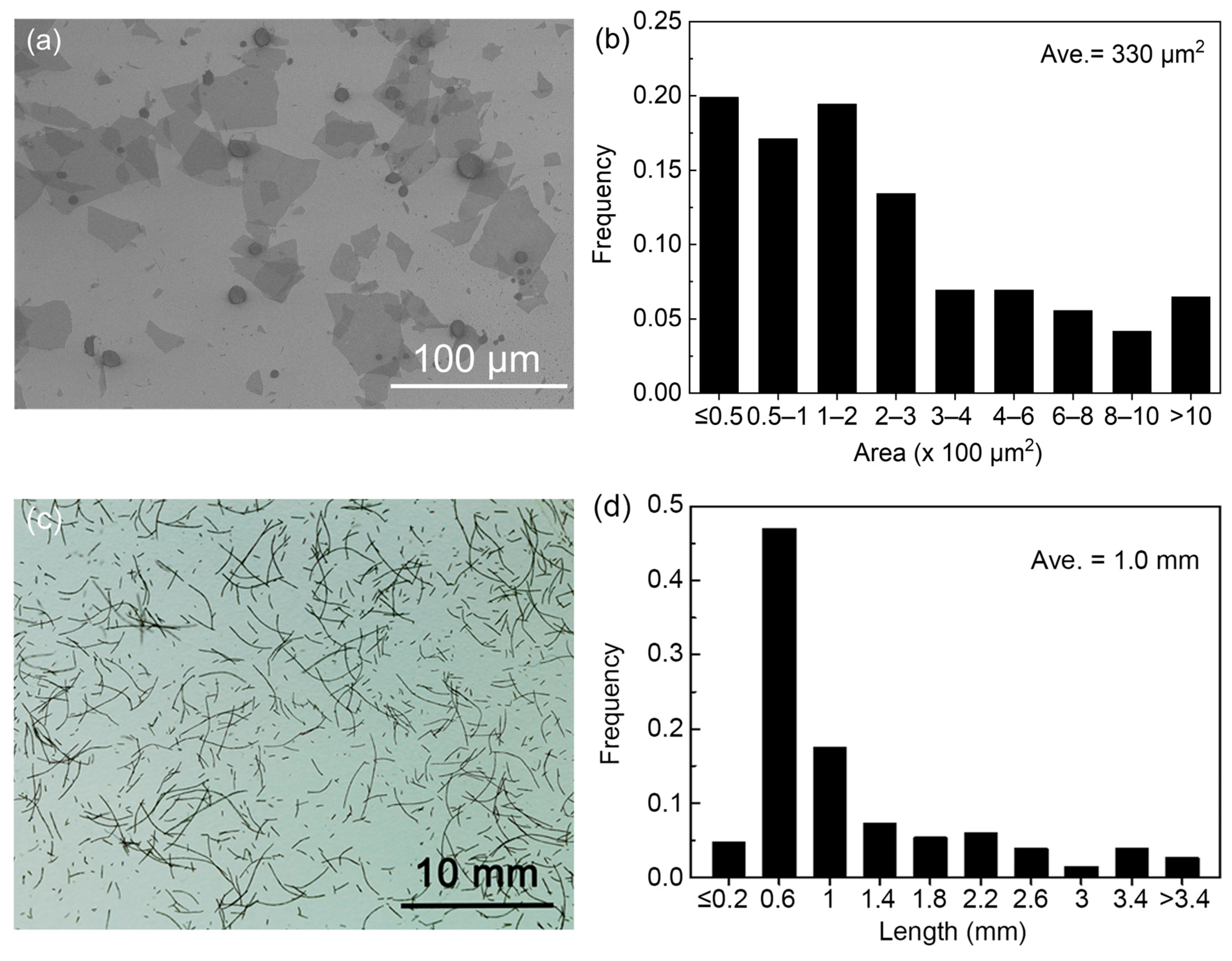

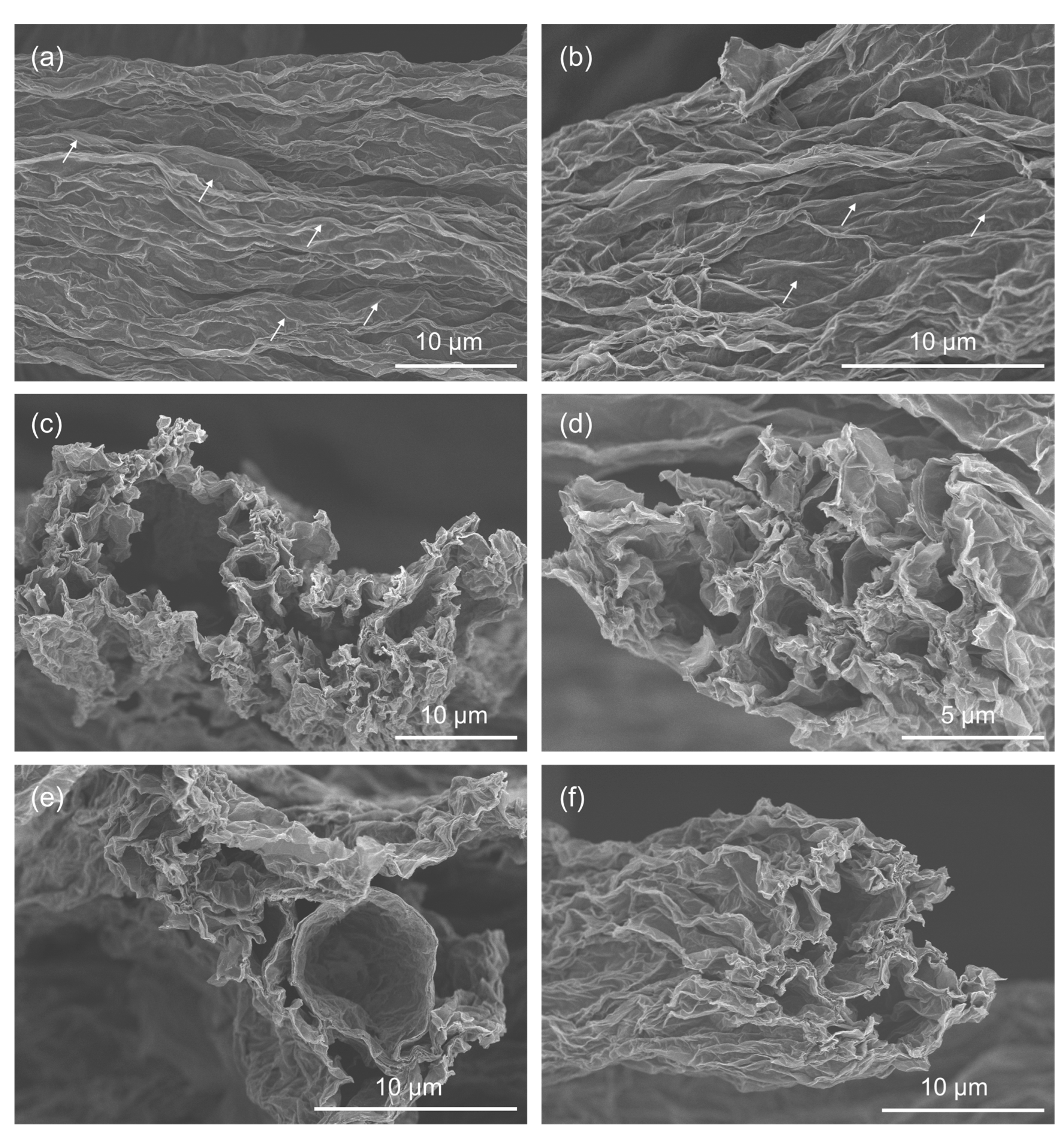
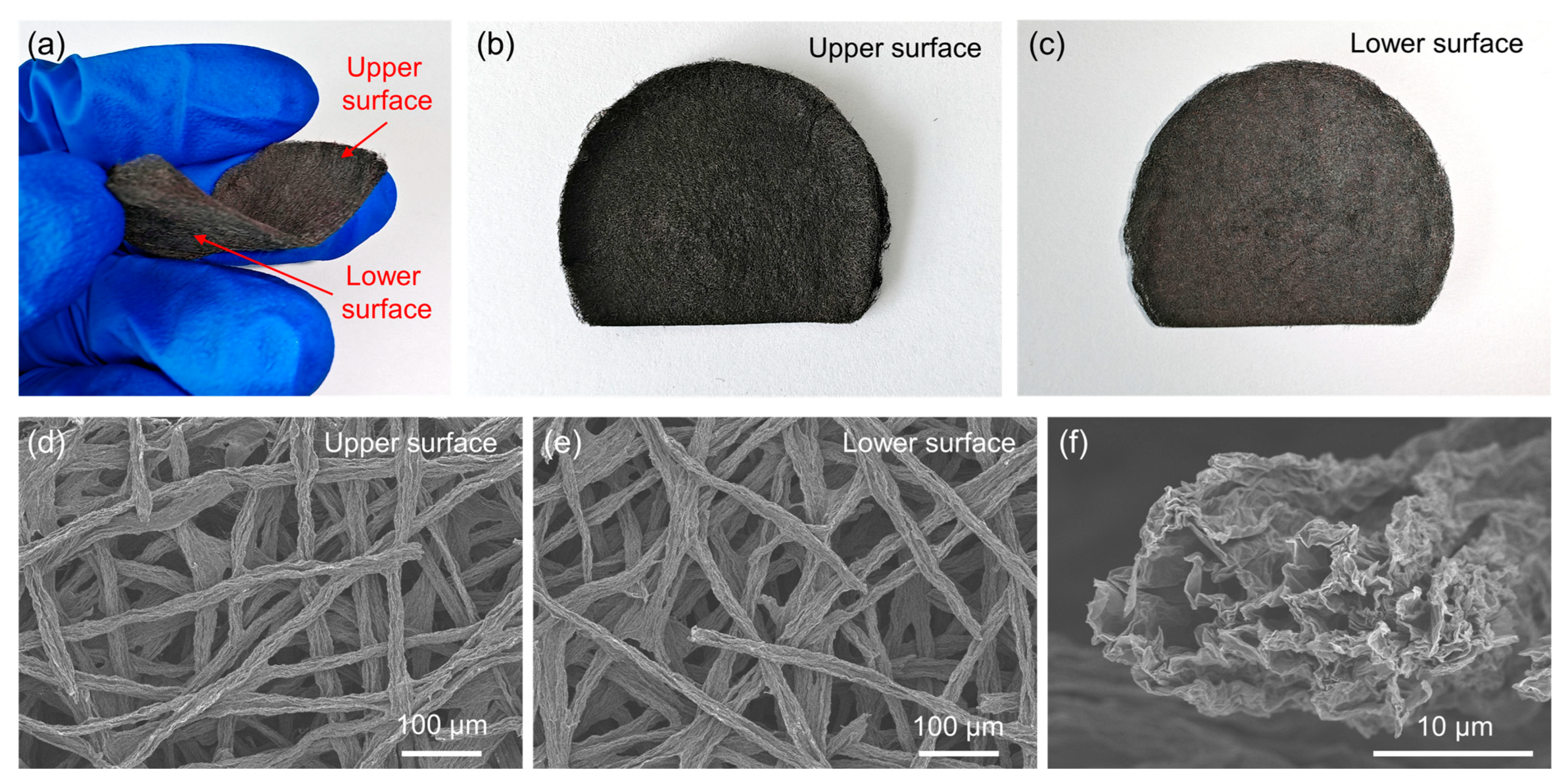
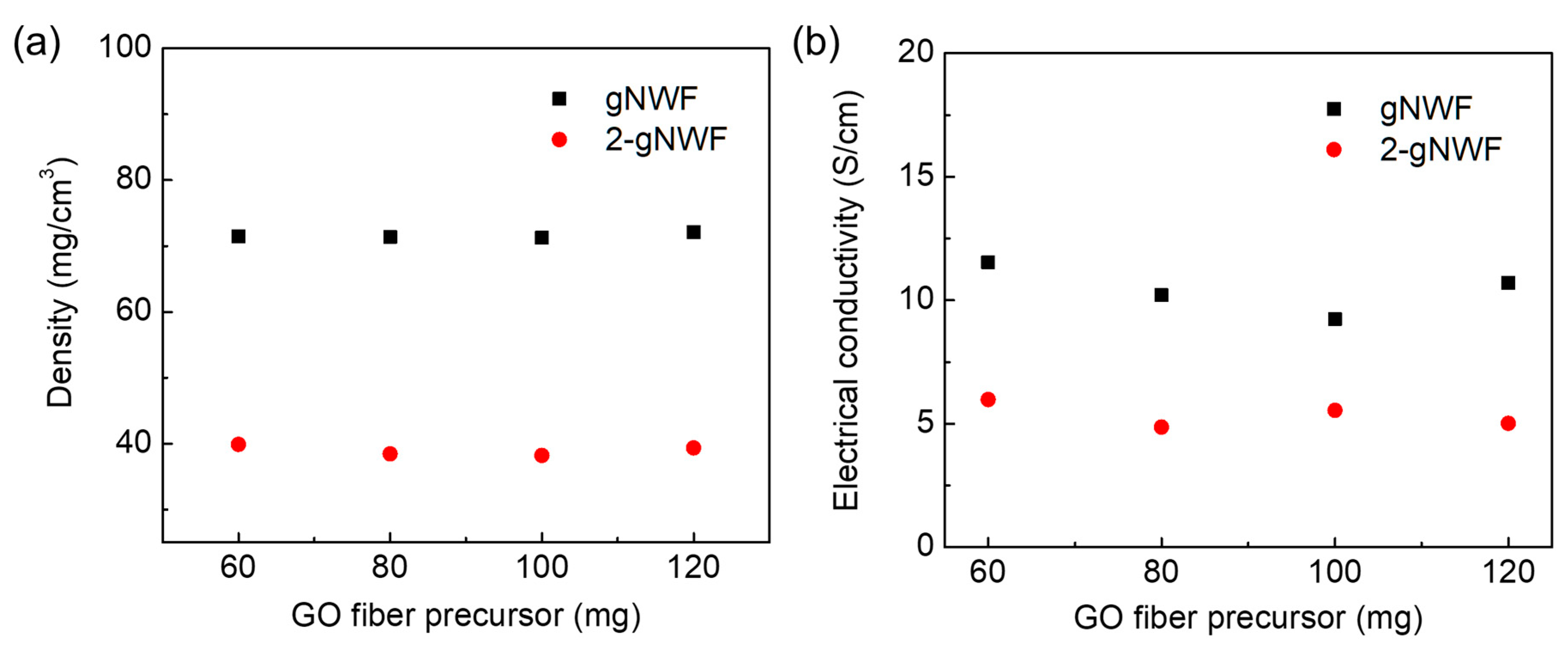

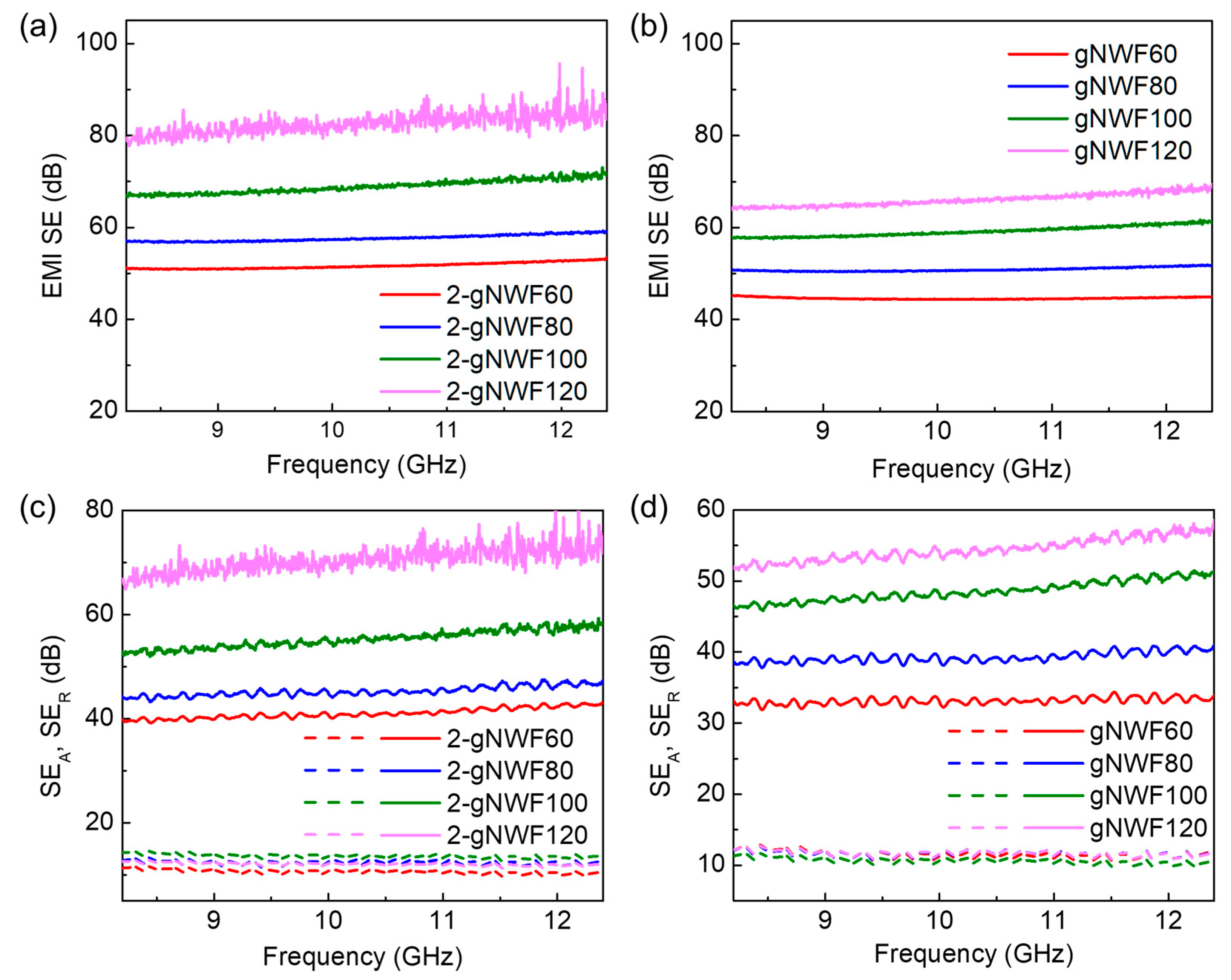
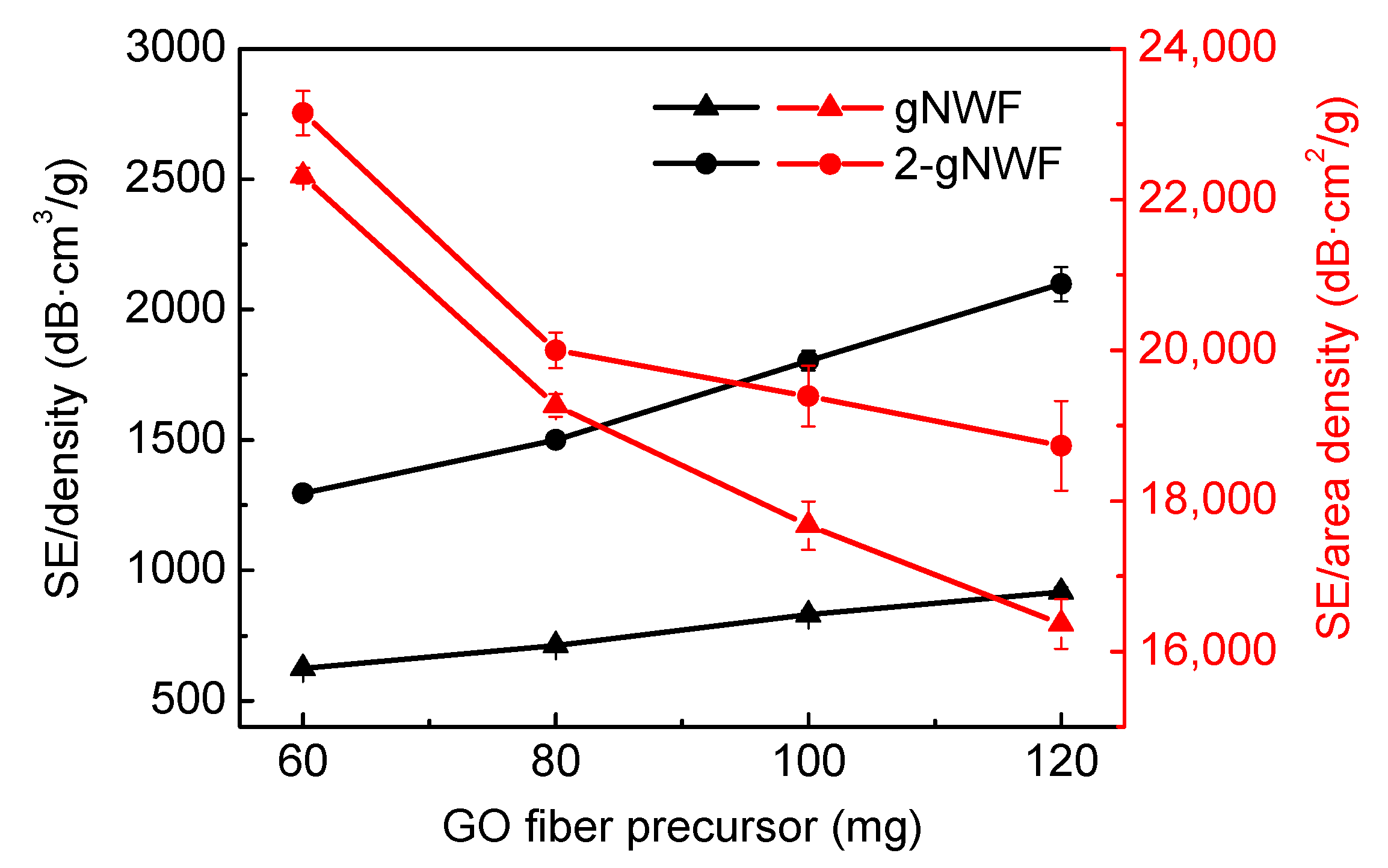
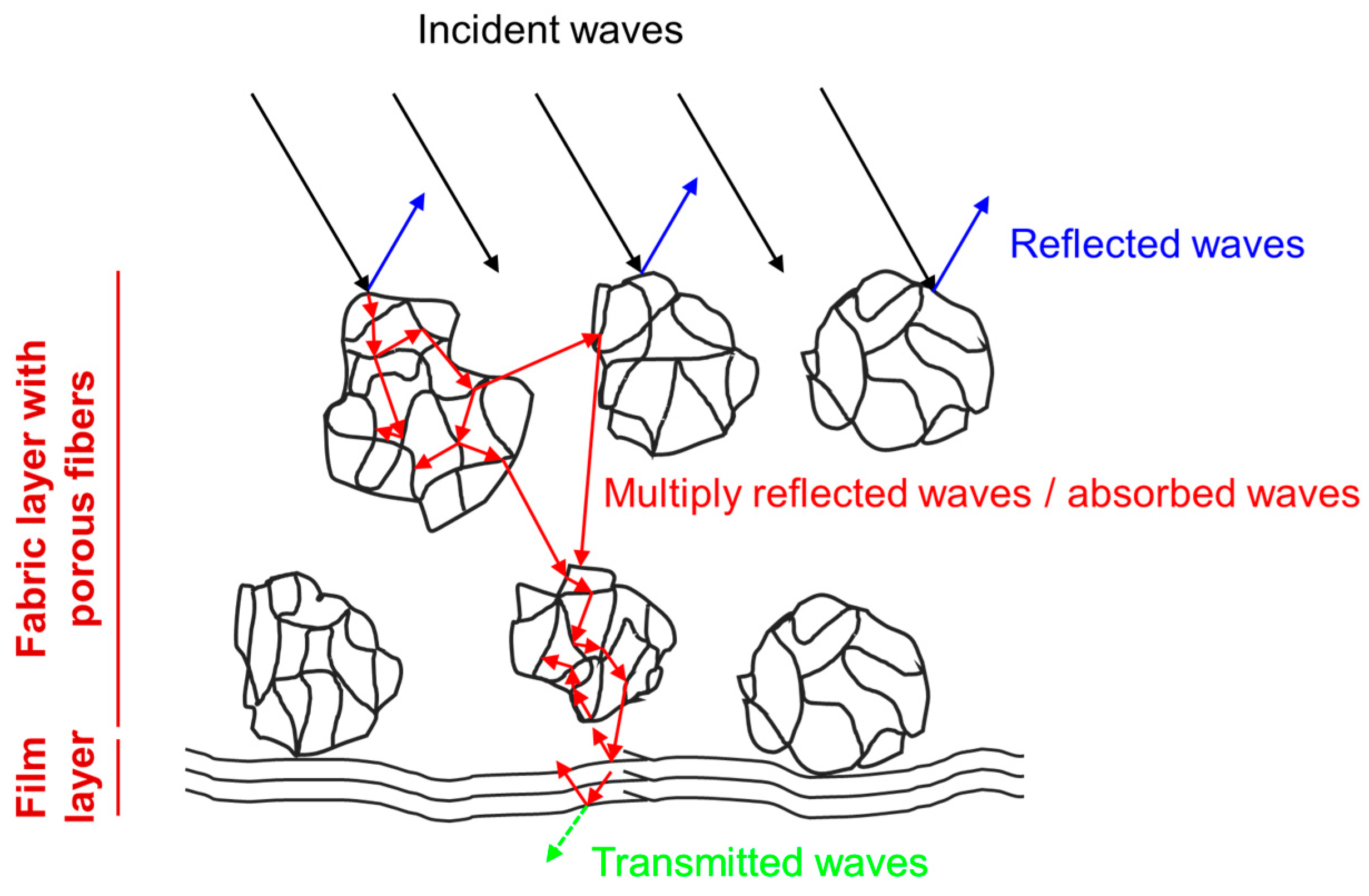
| Material | Electrical Conductivity (S/cm) | Density (g/cm3) | Thickness (mm) | EMI SE (dB) | SE/Density (dB·cm3/g) | SE/Area Density (dB cm2/g) | Ref. |
|---|---|---|---|---|---|---|---|
| rGO film | 117 | - | 0.1 | ~60 | - | - | [36] |
| rGO film | 1780 | 0.91 | 0.013 | ~43 | ~47 | ~36,348 | [37] |
| Porous graphene film | 20.2 | 0.075 | ~0.2 | 43.8 | 640 | 29,178 | [38] |
| rGO foam | 3.1 | 0.06 | 0.3 | 25.2 | 420 | 14,000 | [17] |
| Graphene aerogel film | 2500 | 0.41 | 0.12 | ~75 | 183 | 15,243 | [39] |
| Pristine graphene film | 1340 | 1.49 | 0.1 | ~90 | ~67 | ~6700 | [40] |
| Electrochemically exfoliated graphene film | 600 | - | 0.125 | 108 | - | 93,358 | [41] |
| Graphene aerogel | 1.8 | - | 2.5 | 43 | - | - | [42] |
| Graphene aerogel | 0.01 | 0.006 | 2.5 | 27.6 | 4600 | 18,400 | [43] |
| Honeycomb porous graphene | 4 | 0.0388 | 0.005 | ~40 | ~1030 | ~206,000 | [44] |
| CVD-grown nanoporous graphene | ~33 | 0.045 | 0.03 | 83 | 1844 | 616,300 | [45] |
| CVD-grown graphene paper | 680 | 0.81 | 0.1 | ~100 | ~119 | 11,900 | [46] |
| Laser-induced graphene | ~10 | - | ~0.3 | ~30 | - | - | [47] |
| 2-gNWF | ~5 | 0.039 | 1.12 | ~80 | 2000 | 23,000 | This work |
Disclaimer/Publisher’s Note: The statements, opinions and data contained in all publications are solely those of the individual author(s) and contributor(s) and not of MDPI and/or the editor(s). MDPI and/or the editor(s) disclaim responsibility for any injury to people or property resulting from any ideas, methods, instructions or products referred to in the content. |
© 2024 by the authors. Licensee MDPI, Basel, Switzerland. This article is an open access article distributed under the terms and conditions of the Creative Commons Attribution (CC BY) license (https://creativecommons.org/licenses/by/4.0/).
Share and Cite
Wu, Y.; Tang, H.; Kang, L.; Li, H.; Jiang, N. A Two-Layer Graphene Nonwoven Fabric for Effective Electromagnetic Interference Shielding. Materials 2024, 17, 3747. https://doi.org/10.3390/ma17153747
Wu Y, Tang H, Kang L, Li H, Jiang N. A Two-Layer Graphene Nonwoven Fabric for Effective Electromagnetic Interference Shielding. Materials. 2024; 17(15):3747. https://doi.org/10.3390/ma17153747
Chicago/Turabian StyleWu, Ying, Haijun Tang, Liying Kang, Hongfu Li, and Naisheng Jiang. 2024. "A Two-Layer Graphene Nonwoven Fabric for Effective Electromagnetic Interference Shielding" Materials 17, no. 15: 3747. https://doi.org/10.3390/ma17153747





